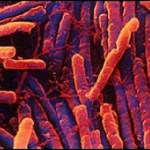hospital
Image of C. difficile from BBC News.
You may recall a prior post about a dog that could smell when patients were infected with Clostridium difficile. C. difficile causes about 14,000 deaths per year in the United States. Recent breakthroughs in understanding gut microbes have led to the successful treatment of C. difficile in patients. Fecal transplants, the transfer of feces from a healthy person, has been life-saving for some patients for whom medical treatments are not effective or for recurrent infections. Listen to Billie's story here. To date, feces have been…
One of the disturbing aspects of the recent E. coli outbreak in Germany was the apparent lack of sufficient hospital surge capacity to handle a sudden influx of seriously ill patients. Der Spiegel reported:
On Monday, hospitals all over northern Germany struggled to treat thousands of patients suffering from the effects of the bacteria. More than one-third of the people infected with E. coli have also come down with a life-threatening complication known as hemolytic-uremic syndrome (HUS) which attacks the blood, kidneys and brain, and has left doctors racing to save lives. Ambulances have…
With nearly one-third of US healthcare spending going to hospital care, it's natural that people would be looking for ways to trim spending on hospital services. A new study just published in the journal Health Affairs reports that seriously ill hospital patients receiving consultations from palliative care teams can incur lower costs. For this study's population - Medicaid patients facing serious or life-threatening illnesses admitted to four New York State hospitals - the authors found that patients who received palliative care consultations incurred costs that averaged $6,900 less than…
I don't have a lot of experience with small hospitals. My medical school's hospital was about two square blocks of buildings, all of them attached, ranging in age from 100 years to 10 years. The were connected by irregular bridges and linked (ex)-fire escapes, and by miles of dim tunnels.
During my residency, the campus covered several square blocks, with buildings linked by more airy bridges (a la Minneapolis) and "secret" tunnels that you could find if you just knew where to look---although getting lost underground was the rule.
My current hospital is---by number of admissions---one of…
